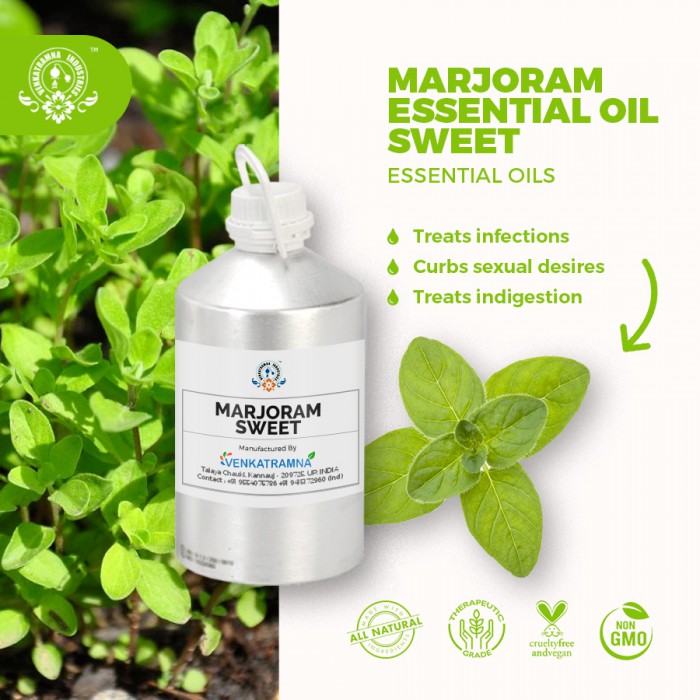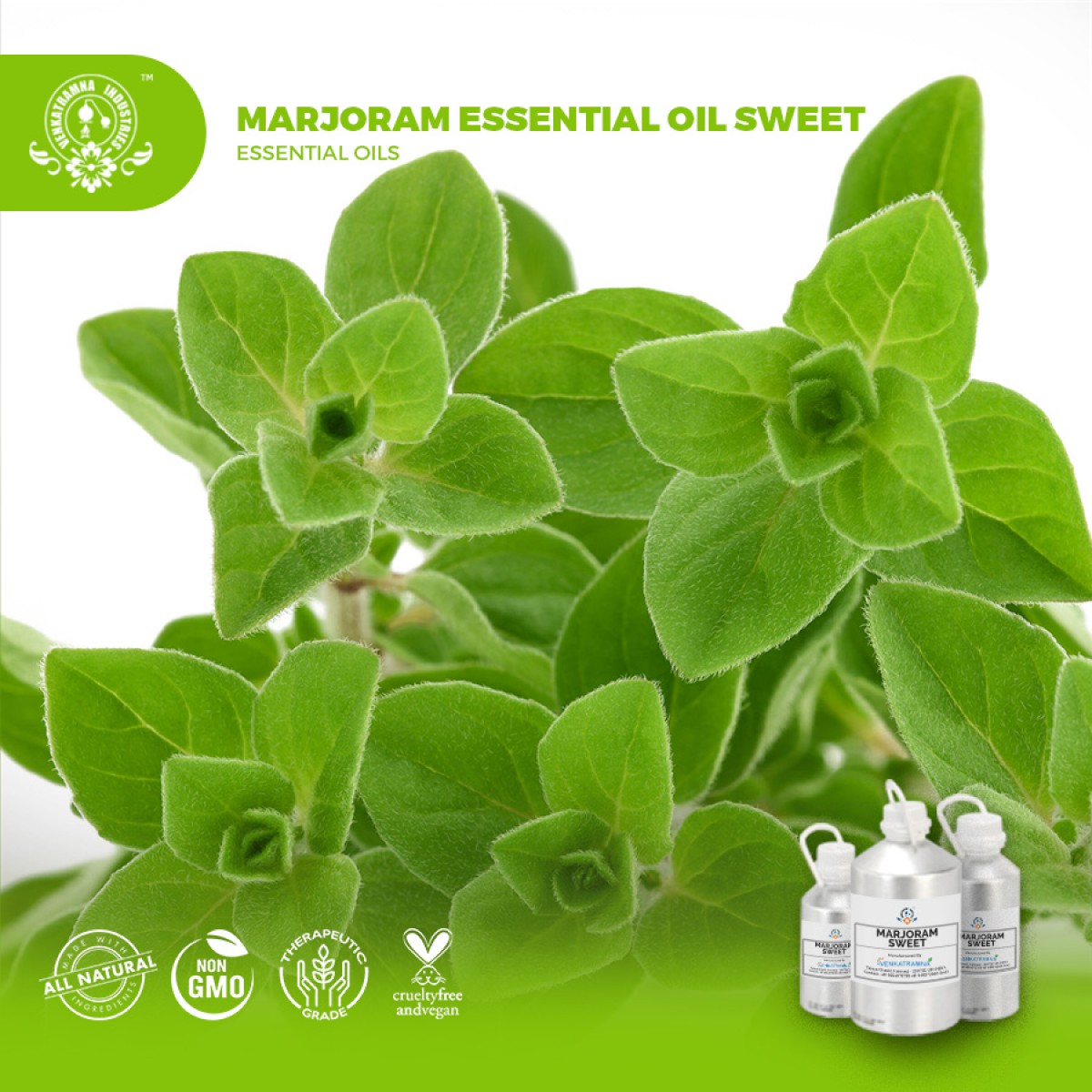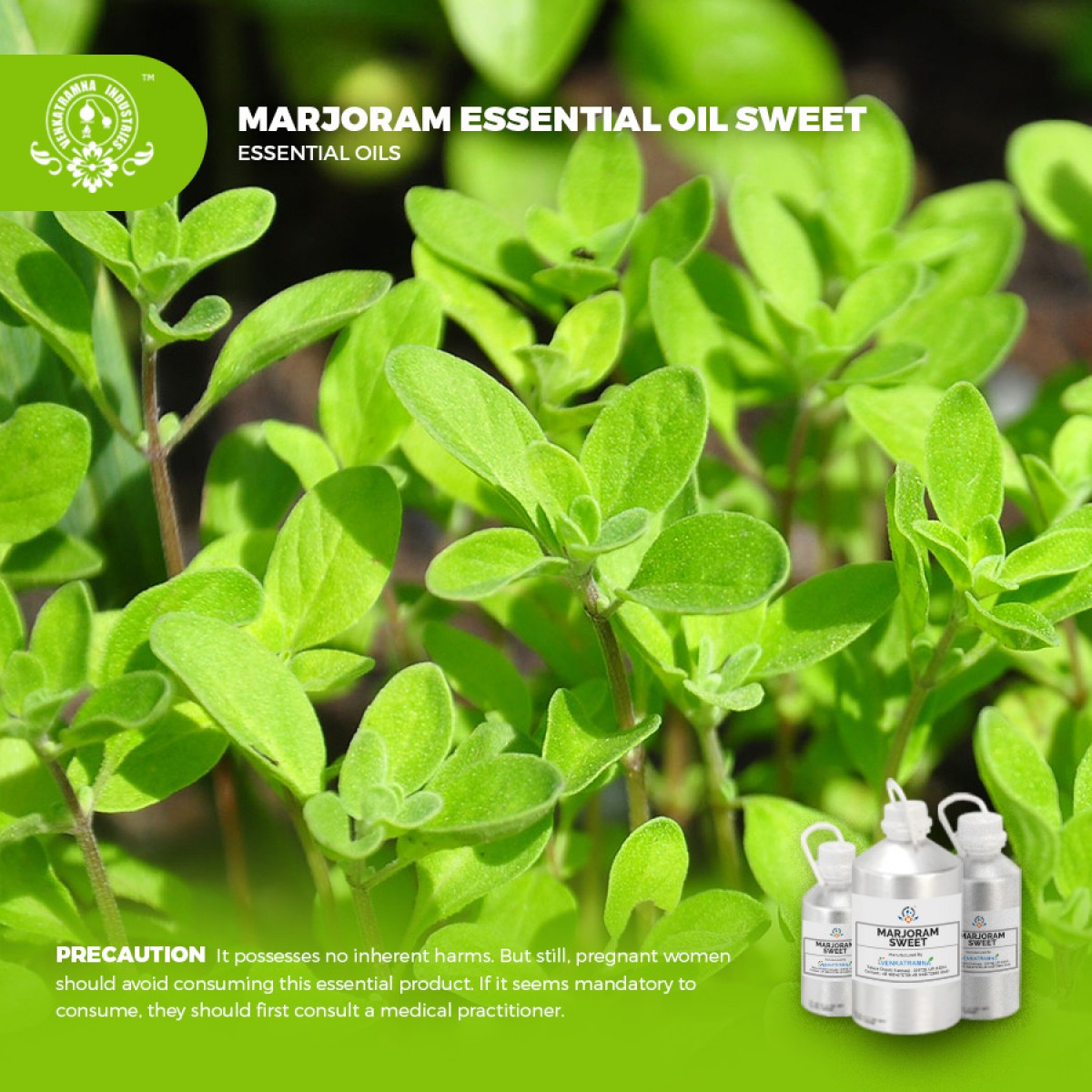Botanical Name: Marjorana Hortensis L Common name: Origanum majorana L, Read More
|
Botanical Name: |
Marjorana
Hortensis L |
|
Common name: |
Origanum majorana L, |
|
Plant
family: |
Lamiaceae |
|
Genus: |
Origanum |
|
Appearance/Color: |
Pale yellow liquid having thin and clear consistency |
|
Odor: |
Marjoram
essential oil lies in middle aroma category thus provides slightly spicy and
warm aroma similar to nutmeg |
|
Blends With: |
Lavender, Orange, Eucalyptus, Frankincense, Elemi, Tea Tree,
Rosewood, Basil, Chamomile, Thyme oils and other spice oils like Cardamom and
Nutmeg. |
|
Origin: |
Egypt |
|
Source: |
Freshly dried flowering plant |
|
Method
of Extraction: |
Steam
Distillation |
Marjoram is a perennial herb from the mint
family. The oil is strictly processed from the extracts of flowering tops of
the marjoram plant by using steam distillation method. This oil is sweet and
used as a surprising curative punch for different types of ailments.
Majorana hortensis (M.) (Sweet
marjoram) of the Labiatae family, is indigenous to mediterranean countries and
was known to the ancient Egyptians, Greeks and Romans. They cultivated it as a
pot herb and used it not only to flavor food but also prized it as a miraculous
herb with the power to heal practically all diseases, especially colds and
chills.
Romans and Greeks citizens consider this organically extracted marjoram essential oil as the herb of happiness, fertility and beauty. In addition, the herb and its processed oil is used in kitchens to add flavors to the different recipes.
DISCLAIMER
The complete range of conditions
or methods of use are beyond our control therefore we do not assume any
responsibility and expressly disclaim any liability for any use of this
product. Information contained herein is believed to be true and accurate however,
all statements or suggestions are made without warranty, expressed or implied,
regarding accuracy of the information, the hazards connected with the use of
the material or the results to be obtained from the use thereof. Compliance
with all applicable federal, state, and local laws and local regulations
remains the responsibility of the user.
The FDA has not evaluated the
statements on this website. No claims are made by Venkatramna Industries as to
the medicinal value of any products from vriaroma.com or by us. The information
presented here is for educating our customers about the traditional uses of
essential oils and is not intended to diagnose, treat, cure, or prevent any
disease. You are responsible for understanding the safe application of these products.
If you have any questions, please call or email us for further information.
As per NAHA guidelines, New Directions Aromatics
(NDA) does not recommend the ingestion of essential oils. It is imperative to
consult a medical practitioner before using Essential Oils for therapeutic
purposes. Pregnant and nursing women and those taking prescription drugs are
especially advised not to use this product without the medical advice of a
physician. The oil should always be stored in an area that is inaccessible to
children, especially those under the age of 7.
Marjoram is
well known for its medicinal properties, Its was initially used by Hippocrates
as an antiseptic agent. It was introduced in the middle ages in Europe and
Greece. To the ancient Greeks, it was ‘amarakos’, a symbol of love, honour and
happiness. Aristotle reported it as an anti-poison. In the old Egypt, marjoram
was used to disinfect and preserve food and its oil was massaged on the
forehead and in the hairs. Dioscorides named it as “sampsouchon”. The people of
Europe used to rub the leaves of the herb on oak pieces of furniture and floors
to get fragrant glow over it. Marjoram
essential oil has tremendous health benefits as it cures Nausea, Asthma,
Fatigue, Rheumatism, Heartburn, etc.
Marjorana hortensis is valued in Indian traditional systems of
medicine for improving antiseptic, antispasmodic, carminative, stimulant, and
expectorant and nerve tonic rheumatic habits, stimulates moreover the blood
circulation, nerve habits, muscle pain, muscle rheumatism, arthritis, flu,
cold, bronchitis, stucked cough, asthma, hiccups, slow digestion, bad appetite,
menstruation problems, low blood pressure, worm infections, cramps, mould
infections, the present review is an up-to-date and comprehensive literature
analysis of the chemistry, ethno pharmacology and therapeutically uses of Marjorana
hortensis.
Majorana
hortensis Moench is an aromatic plant whose importance as a natural medicine
has been known since time immemorial. Its essential oil is used in perfumery
because of its spicy herbaceous notes and also in the manufacture of
fungicides, pharmaceutical and industrial products. Volatile oil is used as an
aromatic stimulant in colic, dyspepsia, flatulence and dysmenorrhoea. In the
food industry it is mainly used as a spice in sausages but its use in baked
goods, processed vegetables, condiments, soups, snack foods and gravies is also
reported.
COMMON
USAGE
·
Cures
twitches
·
Treats
infections
·
Curbs
sexual desires
·
Treats
indigestion
·
Reduces
bacterial infections
·
Improves
Cognitive Functions
·
Good
for Cordial Effect
·
Promotes
digestion
·
Stimulates
urination
·
Promotes
sweating
·
Works
as Emenagogue
·
Treats
fungal infections
·
Ensures
quick wound healing
Ingredients:
|
S.No |
Key Constituents |
Strength (%) |
|
1 |
Linalyl acetate |
7.4–10.5 |
|
2 |
Terpinen-4-ol |
16.4–31.6 |
|
3 |
g-Terpinene |
7.3–9.8 |
|
4 |
a-Terpineol |
3.8–8.3 |
|
5 |
(Z)-Sabinene hydrate |
7.1–13.8 |
|
6 |
(E)-Sabinene
hydrate |
2.4–6.7 |
|
7 |
a-Terpinene |
3.0–5.9 |
|
8 |
Terpinen-4-yl acetate |
2.3–5.7 |
|
9 |
p-Cymene |
2.2–5.3 |
|
10 |
Sabinene |
3.0–5.3 |
|
11 |
Terpinolene |
2.0–2.8 |
|
12 |
Linalool |
1.7-3.3 |
Safety Summary
·
Hazards: Not Known
Organ Specific Effects
·
Acute toxicity: Oral DL 50 (rat)
=>5000 mg/kg Dermal DL 50 (rabbit) =>5000 mg/kg
·
Skin corrosion/irritation: May be
irritating to skin.
·
Serious eye damage/irritation: May be
irritating to eyes. Prompt rinsing and removal of the substance will avoid
damage. Respiratory sensitization: Breathing high concentrations of vapor may
cause anesthetic effects.
·
Germ cell mutagenicity: Not specified
·
Carcinogenicity: IARH: No component of
this product present at levels greater than or equal to 0.1% is identified as
probable, possible or confirmed human carcinogen by IARC.
·
ACGIH: No component of this product
present at levels greater than or equal to 0.1% is identified as probable,
possible or confirmed human carcinogen by IARC.
·
NTP: No component of this product present
at levels greater than or equal to 0.1% is identified as probable, possible or
confirmed human carcinogen by IARC.
·
OSHA: No component of this product
present at levels greater than or equal to 0.1% is identified as probable,
possible or confirmed human carcinogen by IARC.
·
Reproductive toxicity: Not specified
·
STOT-single exposure: Not specified
·
STOT-related exposure: Not specified
·
Aspiration hazard: Not specified
·
Information on the likely routes of exposure:
Skin/scalp contact.
·
Symptoms related to the physical, chemical,
and toxicological characteristics: None known. Irritation of the eye if
exposed: Redness of the skin if irritated.
·
Toxicity
o
Acute fish toxicity: LC50 / 96 HOUR – No data
available
o
Toxicity to aquatic plants – No data available
o
Toxicity to microorganisms – No data available
o
Toxicity threshold – No data available
·
Persistence and degradability:
Biodegradation is expected
·
Bio-accumulative potential:
Bioaccumulation is unlikely
·
Mobility in soil: Unknown
Avoid exposure to marine environments and waterways





 MSDS-Marjoram.pdf
MSDS-Marjoram.pdf




